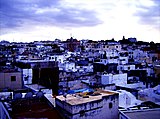Battle of Tangier (1664)
| Battle of Tangier | |||||||
|---|---|---|---|---|---|---|---|
 An illustration of the battle | |||||||
| |||||||
| Belligerents | |||||||
|
|
| ||||||
| Commanders and leaders | |||||||
|
|
| ||||||
| Strength | |||||||
| ~11,000 | 500 | ||||||
| Casualties and losses | |||||||
| Unknown (heavy) | ~470 killed | ||||||
TheBattle of Tangier,also known as theBattle of Jew's Hill,took place between a detachment of theEnglishTangier Garrisonunder the command ofgovernor of TangierLord Teviotby aMoroccanforce commanded byKhadir Ghaïlanon 4 May 1664. Successfullyambushingthe 500-strong English force, Ghaïlan's men killed all but thirty of them, including Teviot. The battle was the bloodiest defeat suffered by the Tangier Garrison during theEnglish occupation of Tangier.
Background[edit]
In 1661, theMoroccancity ofTangier,which had previously been part of thePortuguese Empire,passed underEnglish controlas part of thedowryofCharles II of Englandwhen he marriedCatherine of Braganza.DuringEngland's occupation of Tangier,theTangier Garrison,anEnglish Armyforce sent togarrisonthe city, faced constant attacks from Moroccan forces opposed to their presence in the region. In 1663, Scottish soldierLord Teviotwas sent to Tangier to serve as the city'sgovernor.[1][2]
Upon arriving inNorth Africato take up the post, Teviot implemented major reforms to the Tangier Garrison during his tenure in office. Teviot also ordered the construction of several outlyingfortificationsto protect Tangier and won several victories over the forces ofKhadir Ghaïlan(known to the English as "Guyland" ), a local Moroccan warlord. However, Teviot was frequently frustrated in his plans by a lack ofbuilding materials.[1]
Battle[edit]
On 4 May 1664, Teviot, commanding a 500-strong detachment of Tangier Garrison troops (consisting of a mixture ofEnglishandIrishsoldiers) marched his men towards an area known to the English as Jew's Hill or Jew's Mount. Some historical accounts suggest that Teviot had made plans to gather stocks ofstone,timberand other building materials from the surrounding areas, though other accounts suggested that Teviot's expedition may have been intended toforage the local areaor that he planned to cut down a patch ofbrushwoodthat Moroccan forces had used as cover during their previous attacks on Tangier.[3]
Once Teviot and his men had crossed a river known to the English as Jew's River, they encountered around 3,000 Moroccan warriors. Teviot's men rapidly attacked the Moroccans, driving them off. They pursued the fleeing enemy, but it quickly became apparent that this was a trap as a much larger Moroccan force of 8,000 men under the command of Ghaïlan was waiting toambushthem. The broken terrain was ill-suited for Teviot's men to form their battle ranks, and the engagement quickly devolved intohand-to-hand combatin which Teviot's men were overwhelmed by sheer numbers. Teviot attempted to rally his men on the top of Jew's Hill but waskilled in action.Only around thirty of the five hundred who had marched out escaped back to the safety of Tangier.[3]
Aftermath[edit]
As had occurred in other Anglo-Moroccan conflicts over Tangier, the Moroccansmutilatedthe corpses of Teviot's men who were killed during the battle. Following Teviot's death, the position of governor and command over the Tangier Garrison devolved to his Irish subordinate,John Fitzgerald.Moroccan pressure on Tangier weakened due to political developments occurring elsewhere in Morocco, and Fitzgerald signed severalceasefiretreaties with hostile Moroccan parties, which by 1666 had led to a general peace in English Tangier. Though occasional skirmishes between the Tangier Garrison and Moroccan forces continued to occur, a major battle would not occur until theGreat Siege of Tangierin 1680.[citation needed]
See also[edit]
References[edit]
Citations[edit]
- ^abChilds 2013,pp. 137–139.
- ^Corbett 2016,pp. 5–11.
- ^abChilds 2013,pp. 139–140.
Bibliography[edit]
- Childs, John (2013).The Army of Charles II.Routledge.ISBN978-0415846110.
- Corbett, Julian(2016).England in the Mediterranean: A Study of the Rise and Influence of British Power within the Straits 1603-1713.Vol. 2. Palala Press.ISBN978-1357570835.

